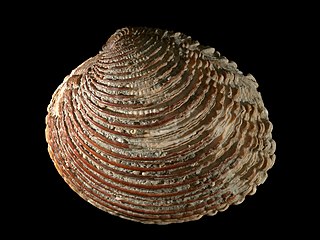
The Veneridae or venerids, common name: venus clams, are a very large family of minute to large, saltwater clams, marine bivalve molluscs. Over 500 living species of venerid bivalves are known, most of which are edible, and many of which are exploited as food sources.
Arthur Adams was an English physician and naturalist.

Nucula is a genus of very small saltwater clams. They are part of the family Nuculidae.

Cuspidariidae is a family of small marine bivalve molluscs in the superfamily Cuspidarioidea.

Solariella is a genus of small to minute sea snails, marine gastropod molluscs in the family Solariellidae within the superfamily Trochoidea, the top snails, turban snails and their allies.

Astartidae is a family of bivalves related in the order Carditida.
Vesicomyidae is a taxonomic family of saltwater clams, marine bivalve molluscs in the superfamily Glossoidea.

Pandoridae is a taxonomic family of small saltwater clams, marine bivalves in the order Anomalodesmata.

The Littorinidae are a taxonomic family of over 200 species of sea snails, marine gastropod molluscs in the clade Littorinimorpha, commonly known as periwinkles and found worldwide.

Gymnobela is a genus of sea snails, marine gastropod mollusks in the family Raphitomidae.

Kurtziella is a genus of small, predatory sea snails, marine gastropod mollusks in the family Mangeliidae.
Cerithiopsis is a genus of very small sea snails, marine gastropod mollusks or micromollusks in the family Cerithiopsidae.

Turbonilla is a large genus of ectoparasitic sea snails, marine gastropod mollusks in the family Pyramidellidae, the pyrams and their allies.
Poromyoidea is a superfamily of molluscs. It used to contain only the family Poromyidae, but now it also contains Cetoconchidae Ridewood, 1903, as CetoconchaDall, 1886 was removed from Poromyidae and given its own family, according to the World Register of Marine Species.

Stenoglene is a genus of moths in the family Eupterotidae from Africa. The genus was described by Felder in 1874.

Propeamussium is a genus of saltwater clams, marine bivalve mollusks in the order Ostreoida.
Cyathodonta is a genus of bivalve mollusc in the family Thraciidae.
Euheterodonta is an infraclass of Mollusca in the class Bivalvia.













